Related Research Articles
Infrared astronomy is a sub-discipline of astronomy which specializes in the observation and analysis of astronomical objects using infrared (IR) radiation. The wavelength of infrared light ranges from 0.75 to 300 micrometers, and falls in between visible radiation, which ranges from 380 to 750 nanometers, and submillimeter waves.

The Very Large Telescope (VLT) is a facility operated by the European Southern Observatory, located on Cerro Paranal in the Atacama Desert of northern Chile. It consists of four individual telescopes, each equipped with a primary mirror that measures 8.2 meters in diameter. These optical telescopes, named Antu, Kueyen, Melipal, and Yepun, are generally used separately but can be combined to achieve a very high angular resolution. The VLT array is also complemented by four movable Auxiliary Telescopes (ATs) with 1.8-meter apertures.
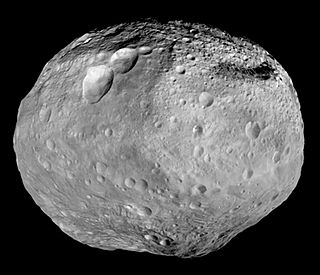
Template:Short description Large planetary embryo

HD 209458 b is an exoplanet that orbits the solar analog HD 209458 in the constellation Pegasus, some 157 light-years from the Solar System. The radius of the planet's orbit is 0.047 AU, or one-eighth the radius of Mercury's orbit. This small radius results in a year that is 3.5 Earth-days long and an estimated surface temperature of about 1,000 °C. Its mass is 220 times that of Earth and its volume is some 2.5 times greater than that of Jupiter. The high mass and volume of HD 209458 b indicate that it is a gas giant.
Darwin was a suggested ESA Cornerstone mission which would have involved a constellation of four to nine spacecraft designed to directly detect Earth-like planets orbiting nearby stars and search for evidence of life on these planets. The most recent design envisaged three free-flying space telescopes, each three to four metres in diameter, flying in formation as an astronomical interferometer. These telescopes were to redirect light from distant stars and planets to a fourth spacecraft, which would have contained the beam combiner, spectrometers, and cameras for the interferometer array, and which would have also acted as a communications hub. There was also an earlier design, called the "Robin Laurance configuration," which included six 1.5 metre telescopes, a beam combiner spacecraft, and a separate power and communications spacecraft.
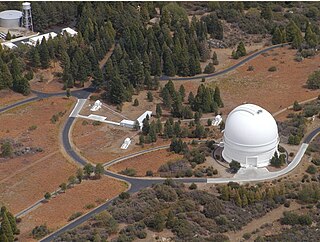
The Palomar Testbed Interferometer (PTI) was a near infrared, long-baseline stellar interferometer located at Palomar Observatory in north San Diego County, California, United States. It was built by Caltech and the Jet Propulsion Laboratory and was intended to serve as a testbed for developing interferometric techniques to be used at the Keck Interferometer. It began operations in 1995 and achieved routine operations in 1998, producing more than 50 refereed papers in a variety of scientific journals covering topics from high precision astrometry to stellar masses, stellar diameters and shapes. PTI concluded operations in 2008 and has since been dismantled.
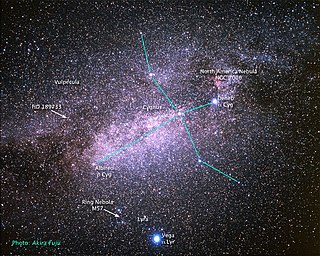
HD 189733, also catalogued as V452 Vulpeculae, is a binary star system approximately 64.5 light-years away in the constellation of Vulpecula. The primary star is suspected to be an orange dwarf star, while the secondary star is a red dwarf star. Given that this system has the same visual magnitude as HD 209458, it promises much for the study of close transiting extrasolar planets. The star can be found with binoculars 0.3 degrees east of the Dumbbell Nebula (M27).
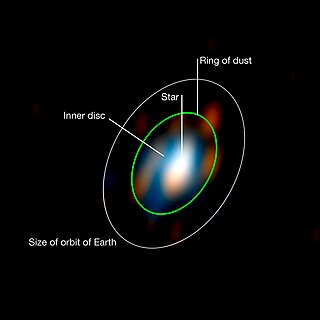
An astronomical interferometer or telescope array is a set of separate telescopes, mirror segments, or radio telescope antennas that work together as a single telescope to provide higher resolution images of astronomical objects such as stars, nebulas and galaxies by means of interferometry. The advantage of this technique is that it can theoretically produce images with the angular resolution of a huge telescope with an aperture equal to the separation, called baseline, between the component telescopes. The main drawback is that it does not collect as much light as the complete instrument's mirror. Thus it is mainly useful for fine resolution of more luminous astronomical objects, such as close binary stars. Another drawback is that the maximum angular size of a detectable emission source is limited by the minimum gap between detectors in the collector array.
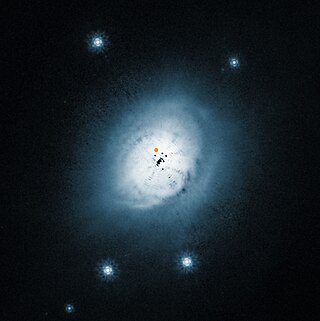
HD 100546, also known as KR Muscae, is a pre-main sequence star of spectral type B8 to A0 located 353 light-years from Earth in the southern constellation of Musca. The star is surrounded by a circumstellar disk from a distance of 0.2 to 4 AU, and again from 13 AU out to a few hundred AU, with evidence for a protoplanet forming at a distance of around 47 AU.
In optical astronomy, interferometry is used to combine signals from two or more telescopes to obtain measurements with higher resolution than could be obtained with either telescopes individually. This technique is the basis for astronomical interferometer arrays, which can make measurements of very small astronomical objects if the telescopes are spread out over a wide area. If a large number of telescopes are used a picture can be produced which has resolution similar to a single telescope with the diameter of the combined spread of telescopes. These include radio telescope arrays such as VLA, VLBI, SMA, astronomical optical interferometer arrays such as COAST, NPOI and IOTA, resulting in the highest resolution optical images ever achieved in astronomy. The VLT Interferometer is expected to produce its first images using aperture synthesis soon, followed by other interferometers such as the CHARA array and the Magdalena Ridge Observatory Interferometer which may consist of up to 10 optical telescopes. If outrigger telescopes are built at the Keck Interferometer, it will also become capable of interferometric imaging.
The Exoplanet Characterisation Observatory (EChO) was a proposed space telescope as part of the Cosmic Vision roadmap of the European Space Agency, and competed with four other missions for the M3 slot in the programme. On 19 February 2014 the PLATO mission was selected in place of the other candidates in the programme, including EChO.

Theta Indi is a binary star in the constellation Indus. Its apparent magnitude is 4.40 and it is approximately 98.8 light years away based on parallax. The smaller companion, B, has a spectral type of G0V and an apparent magnitude of 7.18 at a separation of 6.71". Recent observations suggest the primary is itself a binary with components Aa and Ab orbiting at 0.0617", estimated period about 1.3 years.

VHS J125601.92–125723.9 is a young triple brown dwarf system located in the constellation Corvus approximately 69.0 light-years from the Sun. The system consists of the equal-mass binary VHS J1256–1257AB and the distant planetary-mass companion VHS 1256–1257 b. In 2022, a continuous radio emission from the radiation belts surrounding VHS J1256–1257 was detected.

WASP-121b, formally named Tylos, is an exoplanet orbiting the star WASP-121. WASP-121b is the first exoplanet found to contain water in an extrasolar planetary stratosphere. WASP-121b is in the constellation Puppis, and is about 858 light-years from Earth.

The Habitable Exoplanet Observatory (HabEx) is a space telescope concept that would be optimized to search for and image Earth-size habitable exoplanets in the habitable zones of their stars, where liquid water can exist. HabEx would aim to understand how common terrestrial worlds beyond the Solar System may be and determine the range of their characteristics. It would be an optical, UV and infrared telescope that would also use spectrographs to study planetary atmospheres and eclipse starlight with either an internal coronagraph or an external starshade.

PDS 70 is a very young T Tauri star in the constellation Centaurus. Located 370 light-years from Earth, it has a mass of 0.76 M☉ and is approximately 5.4 million years old. The star has a protoplanetary disk containing two nascent exoplanets, named PDS 70b and PDS 70c, which have been directly imaged by the European Southern Observatory's Very Large Telescope. PDS 70b was the first confirmed protoplanet to be directly imaged.
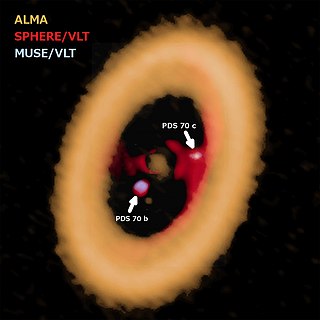
A circumplanetary disk is a torus, pancake or ring-shaped accumulation of matter composed of gas, dust, planetesimals, asteroids or collision fragments in orbit around a planet. Around the planets, they are the reservoirs of material out of which moons may form. Such a disk can manifest itself in various ways.
Katherine Gudrun Isaak is a British astrophysicist and the Project Scientist for the European Space Agency Characterising Exoplanet Satellite mission (CHEOPS). She is based at European Space Research and Technology Centre.

There are several methods currently used by astronomers to detect distant exoplanets from Earth. Theoretically, some of these methods can be used to detect Earth as an exoplanet from distant star systems.
References
- ↑ "Large Interferometer For Exoplanets" . Retrieved November 12, 2022.
- ↑ Quanz, Sascha P. (2022). "Atmospheric characterization of terrestrial exoplanets in the mid-infrared: Biosignatures, habitability, and diversity". Experimental Astronomy. 54 (2–3): 1197–1221. arXiv: 1908.01316 . doi:10.1007/s10686-021-09791-z. PMC 9998579 . PMID 36915622.
- ↑ Bonati, Irene (18 Nov 201). "Direct imaging of molten protoplanets in nearby young stellar associations". Astronomy & Astrophysics. 621: A125. arXiv: 1811.07411 . Bibcode:2019A&A...621A.125B. doi:10.1051/0004-6361/201833158. S2CID 119455048.
- ↑ Defrère, D. (26 Jul 2018). "Characterizing the atmosphere of Proxima b with a space-based mid-infrared nulling interferometer". In Tuthill, Peter G.; Creech-Eakman, Michelle J.; Mérand, Antoine (eds.). Optical and Infrared Interferometry and Imaging VI. Vol. 10701. p. 36. arXiv: 1807.09996 . Bibcode:2018SPIE10701E..1HD. doi:10.1117/12.2312839. ISBN 9781510619555. S2CID 118991382.
- ↑ Defrère, D. (21 Dec 2018). "Space-based infrared interferometry to study exoplanetary atmospheres". Experimental Astronomy. 46 (3): 543–560. arXiv: 1801.04150 . Bibcode:2018ExA....46..543D. doi:10.1007/s10686-018-9613-2. S2CID 254514482.
- ↑ Kammerer, J.; Quanz, S. P. (17 Oct 2017). "Simulating the exoplanet yield of a space-based mid-infrared interferometer based on Kepler statistics". Astronomy & Astrophysics. 609: A4. arXiv: 1707.06820 . doi:10.1051/0004-6361/201731254. S2CID 54748356.

